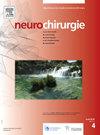Highly cited scores, scoring systems, grading systems, and classifications of daily use in cranial neurosurgery: A must-have during residency training! A mini-review
IF 1.4
4区 医学
Q4 CLINICAL NEUROLOGY
引用次数: 0
Abstract
Context
Neurosurgery has much evolved since the time of Kocher and Cushing. Thanks to operative microscope, radiation therapy, progress of neuroresuscitation care, and data from evidence-based neurosurgical research, neurosurgery patients’ prognostic has improved. Now more than ever, we need simple, reliable, and reproducible scores, grades, and classifications to assist us in the surgical decision making, to assess patients’ clinical evolution, and to conduct proper neurosurgical research.
Materials and methods
We conducted a three stage scoping review: (1) identification of sections of interest: brain trauma, tumor, vascular, infection, stroke, functional outcome (2) identification of the most common diseases within each section, (3) we retained every score, scale, classification that is internationally recognized and/or highly cited and/or used daily in clinical practice or research setting and/or that is currently used by the author.
Results
23 scores were retained. Brain trauma section: Glasgow coma scale (1974), Glasgow Liège scale (1982), SHE score (2019), RASH score (2022). Tumor section: Karnofsky Performance status (1948), Graded Prognostic Assessment (2008), Simpson grade (1957), Sindou grade (2006), House and Brackmann (1983), Koos grade (1993), Knosp scale (1993). Vascular section: PHASES score (2014), UIATS score (2015), Hunt and Hess scale (1968), Fisher scale (1980), WFNS scale (1988), Spetzler Martin scale (1986), Borden scale (1995), Cognard scale (1995), Zabramski scale (1995). Stroke section: ICH score (2001), NIHSS (1989). Functional outcome section: Rankin scale (1957).
Conclusion
We provide a non-exhaustive list of 23 reference scales, scores, and classifications that can be safely used for cranial neurosurgery clinical practice and research.
高引用分数,评分系统,评分系统和分类在颅神经外科的日常使用:住院医师培训期间必须有!一个原子力
自Kocher和Cushing时代以来,神经外科已经有了很大的发展。由于手术显微镜、放射治疗、神经复苏护理的进展以及循证神经外科研究的数据,神经外科患者的预后得到了改善。现在,我们比以往任何时候都更需要简单、可靠、可重复的评分、分级和分类,以帮助我们做出手术决策,评估患者的临床进展,并进行适当的神经外科研究。材料和方法我们进行了三个阶段的范围审查:(1)确定感兴趣的部分:脑外伤、肿瘤、血管、感染、中风、功能结局;(2)确定每个部分中最常见的疾病;(3)我们保留了国际公认和/或高引用和/或在临床实践或研究环境中日常使用和/或作者目前使用的每一个评分、量表和分类。结果共保留23个评分。脑外伤部分:Glasgow昏迷量表(1974)、Glasgow li量表(1982)、SHE评分(2019)、RASH评分(2022)。肿瘤切片:Karnofsky Performance status(1948),分级预后评估(2008),Simpson分级(1957),Sindou分级(2006),House and Brackmann (1983), Koos分级(1993),Knosp量表(1993)。血管切片:PHASES评分(2014)、UIATS评分(2015)、Hunt and Hess量表(1968)、Fisher量表(1980)、WFNS量表(1988)、Spetzler Martin量表(1986)、Borden量表(1995)、Cognard量表(1995)、Zabramski量表(1995)。卒中部分:ICH评分(2001),NIHSS评分(1989)。功能结果部分:Rankin量表(1957)。结论我们提供了一份不完全的23种参考量表、评分和分类,可用于颅神经外科临床实践和研究。
本文章由计算机程序翻译,如有差异,请以英文原文为准。
求助全文
约1分钟内获得全文
求助全文
来源期刊

Neurochirurgie
医学-临床神经学
CiteScore
2.70
自引率
6.20%
发文量
100
审稿时长
29 days
期刊介绍:
Neurochirurgie publishes articles on treatment, teaching and research, neurosurgery training and the professional aspects of our discipline, and also the history and progress of neurosurgery. It focuses on pathologies of the head, spine and central and peripheral nervous systems and their vascularization. All aspects of the specialty are dealt with: trauma, tumor, degenerative disease, infection, vascular pathology, and radiosurgery, and pediatrics. Transversal studies are also welcome: neuroanatomy, neurophysiology, neurology, neuropediatrics, psychiatry, neuropsychology, physical medicine and neurologic rehabilitation, neuro-anesthesia, neurologic intensive care, neuroradiology, functional exploration, neuropathology, neuro-ophthalmology, otoneurology, maxillofacial surgery, neuro-endocrinology and spine surgery. Technical and methodological aspects are also taken onboard: diagnostic and therapeutic techniques, methods for assessing results, epidemiology, surgical, interventional and radiological techniques, simulations and pathophysiological hypotheses, and educational tools. The editorial board may refuse submissions that fail to meet the journal''s aims and scope; such studies will not be peer-reviewed, and the editor in chief will promptly inform the corresponding author, so as not to delay submission to a more suitable journal.
With a view to attracting an international audience of both readers and writers, Neurochirurgie especially welcomes articles in English, and gives priority to original studies. Other kinds of article - reviews, case reports, technical notes and meta-analyses - are equally published.
Every year, a special edition is dedicated to the topic selected by the French Society of Neurosurgery for its annual report.
 求助内容:
求助内容: 应助结果提醒方式:
应助结果提醒方式:


